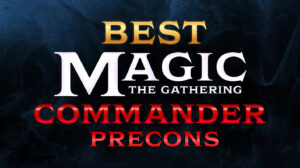How to Play Magic: The Gathering? Rules, Cards & Tips
Eneba Hub contains affiliate links, which means we may earn a small commission if you make a purchase through them—at no extra cost to you. Learn more
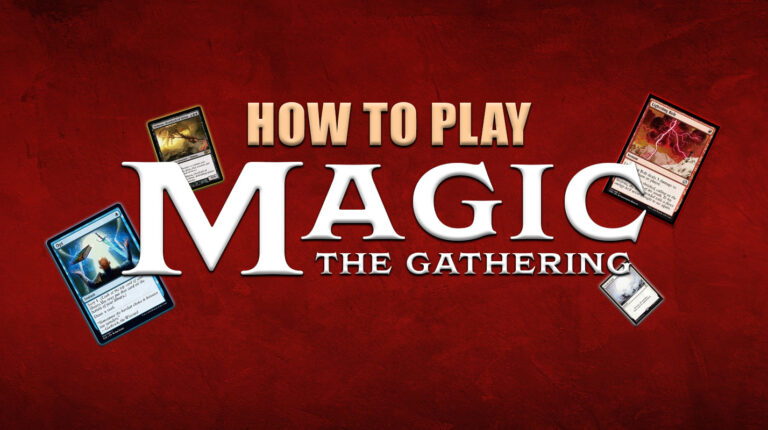
Ready to learn how to play Magic: The Gathering like a pro? This iconic collectible card game blends strategy, creativity, and a touch of wizardry, captivating millions with its endless possibilities. Whether you’re slinging spells as a planeswalker or outsmarting opponents with clever tactics, Magic offers a thrilling ride for newbies and veterans alike.
In this article, I’ll break down the basics – deck construction, gameplay mechanics, and tips to dominate your first match. Get ready to tap lands, cast game-changing spells, and unleash your inner strategist.
No prior experience? No problem! I’ll guide you through the multiverse with a cool, clear vibe, so grab your cards, shuffle up, and let’s spark some Magic!
Jump to:
What is Magic: The Gathering?
Step into the swirling chaos and cleverness that is Magic: The Gathering – a collectible card game that didn’t just break the mold in 1993, it set fire to it and reshaped an entire genre. Dreamed up by Wizards of the Coast, this legendary card-slinger didn’t just launch a game – it launched an obsession.
What started as a niche curiosity is now a global community pulsing with deck builders, lore lovers, and strategy addicts. And decades later? Magic’s still here, still evolving, and still casting spells on new generations.
At heart, Magic is a duel of minds, powered by cardboard and imagination. You don’t just play – you conjure. Armed with a custom-built deck from an ocean of uniquely weird, wicked, and wonderfully illustrated cards, you step into the boots of a planeswalker – basically a dimension-hopping mage with a serious flair for drama.
What makes Magic sing is its deliciously intricate strategy. Every match is a cerebral showdown, where crafting your deck and making split-second choices demand guile and vision.
You’ll harness five vibrant mana colors – white, blue, black, red, and green – each with its own swagger, from blue’s sly counter-magic to red’s molten fury. Let’s take a closer look at how each one plays out!
| Color | Vibe & Flavor | Strengths | Weaknesses |
|---|---|---|---|
| White | Order and justice. The noble protector who brings balance, healing, and a sense of community to every match. | Building armies of small creatures, life gain, protective spells. | Often lacks explosive finishers. |
| Blue | The thinker. The cunning strategist who loves illusions, control, and outsmarting opponents. | Card draw, counterspells, flying creatures. | Can feel slow and reactive. |
| Black | Risk and power. The daring tactician who bends the rules, thrives on sacrifices, and embraces the shadows. | Creature removal, graveyard tricks, life-drain. | Usually pays with life or resources. |
| Red | Chaos and passion. The fiery force of recklessness and rapid attacks that keeps everyone on edge. | Direct damage, aggressive creatures, speed. | Can run out of steam quickly. |
| Green | Nature’s might. The unstoppable force of wild growth, big beasts, and a primal connection to the land. | Ramp (mana growth), huge creatures, direct fighting. | Can be vulnerable to control decks. |
Whether you’re clashing with pals over a creaky table, dueling in high-stakes tournaments, or diving into the digital realm of MTG Arena, Magic: The Gathering is a kaleidoscope of thrills that never stops evolving. It’s where imagination arm-wrestles competition, where one clever card can flip the script, and every game feels like a tale
What Do You Need To Start Playing?
Ready to jump into Magic: The Gathering? Getting started is super simple, and you don’t need much to begin casting spells and battling opponents. Here’s the lowdown on what you’ll need to kick off your planeswalker journey.
First, you’ll need a deck – your core toolkit. A standard deck has 60 cards, while Commander format uses 100 cards, including one legendary “commander” card.
Decks are split into lands (which generate mana, the game’s energy) and spells (creatures, enchantments, instants, and more that bring the action). Prebuilt decks are great for beginners, or you can craft your own from your card collection.
Next, you’ll need a way to track life totals. Each player starts at 20 life (40 in Commander). Use dice, a notepad, or a free app like MTG Arena to keep score.
A playmat is optional but awesome – it keeps your cards organized and adds flair to your setup. Many players also use dice or counters to track special abilities, like +1/+1 boosts on creatures, or to represent tokens (temporary creatures created by spells).
That’s it! Grab a deck, something to track life, and maybe a few dice, and you’re ready to duel. Start small, experiment with cards, and dive into the fun of Magic!
Basic Rules: The Core Concepts
Welcome to the heart of Magic: The Gathering! The game’s rules are straightforward once you grasp the core concepts. Let’s break down the essentials you need to start playing, focusing on life totals, winning, key game zones, and casting spells.
1. Life Totals
Every player begins with a life total – 20 in most formats, or 40 in Commander. Think of it as your health bar. When you take damage (from creatures or spells), your life total drops. Track it with dice, paper, or an app. If your life hits zero, you lose, so protect it!
2. Winning the Game
Victory comes in a few ways. The most common is reducing your opponent’s life total to zero – land those big hits! You can also win if your opponent needs to draw a card but their deck is empty (called “decking out”).
Some cards have special effects that can declare you the winner instantly, like “You win the game” conditions. Keep these goals in mind as you play.
3. Key Game Zones
- Deck: Your stack of 60 cards (100 for Commander). You draw from here to build your hand.
- Hand: Cards you hold, ready to play. You can have up to seven cards (draw more if you go below).
- Battlefield: Where played cards go – lands, creatures, and other spells live here, ready to act.
- Graveyard: Used or destroyed cards go here, like a discard pile.
- Exile: Cards removed from the game entirely, usually by specific effects. They’re out for good!
4. Casting Spells
Spells are the heart of Magic. To cast one, you need mana, the game’s magical energy. Mana comes from lands, like Forests or Mountains, which you play once per turn. Each spell has a mana cost (like “2 blue mana” or “3 colorless, 1 red”).
Tap your lands (turn them sideways) to pay the cost, then the spell hits the battlefield. Creatures fight, instants zap, and enchantments linger – each does something cool!
Some spells – like creatures, artifacts, enchantments, and planeswalkers – stay on the battlefield. These are called permanent spells while being cast, and become permanents once they resolve. Others, like instants and sorceries, are one-shot effects that go to the graveyard after they do their thing.
That’s the core! Shuffle your deck, draw seven cards, and start with one player going first (decide with a coin flip or dice).
The Turn Structure: A Step-by-Step Guide
Magic: The Gathering turns are like a rhythm, guiding your strategy step by step. Each turn has seven phases, and knowing them makes gameplay smooth.
- Untap: Untap your tapped cards to ready them.
- Upkeep: Handle effects that trigger at the start.
- Draw: Draw one card from your deck.
- Main Phase: Play one land per turn and cast spells.
- Combat Phase: Attack with creatures; opponent may block.
- Main Phase 2: Play more spells or lands (one max!).
- End Phase: Wrap up effects, end turn.
Now, let’s take a closer look at each of them.
1. Untap Phase
Your turn kicks off with the untap phase. All your tapped cards – lands, creatures, or artifacts – straighten up, ready for action. Tapped cards are sideways, showing they’ve been used; untapping resets them. You don’t choose what to untap – everything you control automatically untaps, giving you a fresh start.
This phase is quick but crucial, as it unlocks your resources for the turn. For example, untapped lands mean you can produce mana again, and untapped creatures are ready to attack or block. No spells or actions happen here; it’s just a reset to prep for the magic ahead.
2. Upkeep Phase
Next comes the upkeep phase, a quick moment before drawing your card. This is when certain card effects trigger, like “At the beginning of your upkeep, gain 1 life.” You resolve these effects one by one. It’s also a chance for opponents to play instants or abilities, so stay alert!
Not every turn has upkeep triggers, so it can pass quickly. Think of it as a brief pause to handle special card instructions before diving into the meat of your turn. Check your cards for “upkeep” text, resolve them, and move on.
3. Draw Phase
The draw phase is simple but exciting – you draw one card from your deck to add to your hand. This happens automatically at the start of your turn (except the first turn’s player, who skips it). Drawing fuels your strategy, giving you new spells or lands to play.
If your deck’s empty when you need to draw, you lose, so watch your card count! Opponents can play instants here, but it’s usually quick. This phase keeps your hand stocked, letting you plan your next move. Draw your card, check your options, and get ready to make some magic.
4. Main Phase (Playing Lands/Spells)
The first main phase is your time to shine. You can play one land per turn from your hand, setting up mana for spells. Then, cast spells – creatures, sorceries, enchantments, or artifacts – as long as you have enough mana.
Tap lands to pay the mana cost, moving cards from your hand to the battlefield. You can also activate abilities on cards unless they say otherwise.
This phase is all about building your strategy, whether summoning a dragon or casting a game-changing permanent spell. Plan carefully, as mana doesn’t carry over. Make your moves and set up for combat!
5. Combat Phase (Attacking/Blocking)
The combat phase is where battles erupt! First, you choose which creatures attack your opponent or their planeswalkers. Tap those creatures to show they’re attacking – you can’t attack with tapped ones.
The defending player then selects their blocking creatures in response to your attack. Unblocked attackers deal damage to the opponent’s life total, while blocked creatures deal damage to each other.
Damage is based on a creature’s power (first number in power/toughness). You don’t have to attack, but it’s your chance to chip away at their life. Opponents can cast instants here, so expect surprises. Fight smart and swing for victory!
6. Main Phase 2
After the combat phase, you get a second main phase to keep building your strategy. Like the first main phase, you can play a land (if you didn’t earlier) and use spells – creatures, enchantments, or sorceries – using available mana.
This phase is great for playing cards you held back or reacting to combat results, like summoning a new creature to bolster your defenses. You can also activate abilities, like equipping artifacts.
It’s a second chance to shape the battlefield before your turn ends. Use it wisely to set up for your next turn or counter your opponent’s moves. Mana’s still limited, so prioritize!
7. End Phase
The end phase wraps up your turn. First, resolve any “until end of turn” effects, like temporary boosts (+2/+2 until end of turn). Then, discard down to seven cards if your hand has more – extra cards go to the graveyard. Finally, all damage on creatures (from combat) clears, but they don’t heal fully unless a card says so.
This phase is automatic, with no new spells allowed, though opponents can play instants. It’s a quick cleanup to reset for your opponent’s turn. Check your hand, clear effects, and pass the turn – you’re ready for the next round!
Card Types to Know & How They Work
In Magic: The Gathering, each card falls into a specific type with its own role in the game. You’ll cast spells, summon creatures, and play lands to outsmart your opponent. Once the basics click, upgrade your list with the best equipment cards MTG for extra power and synergy.
Get familiar with these seven main types: Creature, Sorcery, Instant, Enchantment, Artifact, Planeswalker, and Land – each bringing unique abilities to your deck.
1. Lands
Land cards are the backbone of every deck. They provide mana – the energy you need to play spells. You can play one land per turn, and each basic land type (Plains, Island, Swamp, Mountain, Forest) taps to produce a different color of mana. There are also non-basic lands with special abilities
Land cards don’t cost mana to play, and they usually stay on the battlefield once played. Without enough lands, your deck simply won’t function, making them crucial for any strategy.
2. Creatures
Creatures are your frontline attackers and defenders. Once summoned, they can block opposing creatures and swing at your opponent’s life total on your turn.
Creatures have power (how much damage they deal) and toughness (how much they can take). Some have special abilities like flying, deathtouch, or haste. Creatures can be small and fast or massive game-enders.
Many decks are built around creature synergies, and battles often come down to how cleverly you use them. They stay on the battlefield unless destroyed or exiled, and they’re key to both offense and defense. If Magic is war, creatures are your army.
Here are a few examples to help you get the feel of this type.

| Card Name | Nefarox, Overlord of Grixis |
| Mana Cost | {4}{B}{B} (4 colorless, 2 black) |
| Card Type | Legendary Creature – Demon |
| Set Symbol & Rarity | Magic 2013 (M13), Rare |
| Abilities | FlyingExalted (Whenever a creature you control attacks alone, that creature gets +1/+1 until end of turn.)Whenever Nefarox attacks alone, defending player sacrifices a creature. |

| Card Name | Renata, Called to the Hunt |
| Mana Cost | {2}{G}{G} (2 colorless, 2 green) |
| Card Type | Legendary Enchantment Creature – Demigod |
| Set Symbol & Rarity | Multiverse Legends (MUL-028), Uncommon |
| Abilities | Renata’s power is equal to your devotion to green. Each other creature you control enters the battlefield with an additional +1/+1 counter on it. |

| Card Name | Etrata, the Silencer |
| Mana Cost | {2}{U}{B} (2 colorless, 1 blue, 1 black) |
| Card Type | Legendary Creature – Vampire Assassin |
| Set Symbol & Rarity | Guilds of Ravnica, Rare |
| Abilities | Etrata, the Silencer can’t be blocked.Whenever Etrata deals combat damage to a player, exile target creature that player controls and put a hit counter on that card. That player loses the game if they own three or more exiled cards with hit counters on them. Etrata’s owner shuffles Etrata into their library. |
3. Instants
Instants are fast, flexible spells you can play any time – even on your opponent’s turn. That makes them perfect for surprise plays, like destroying a creature mid-attack or countering an opponent’s spell.
Most instants do something quickly and then go to the graveyard. They cost mana just like other spells, but their power lies in timing.

| Card Name | Lightning Bolt |
| Mana Cost | {R} (1 red mana) |
| Card Type | Instant |
| Set Symbol & Rarity | Modern Masters 2015, Uncommon |
| Abilities | Lightning Bolt deals 3 damage to any target. |
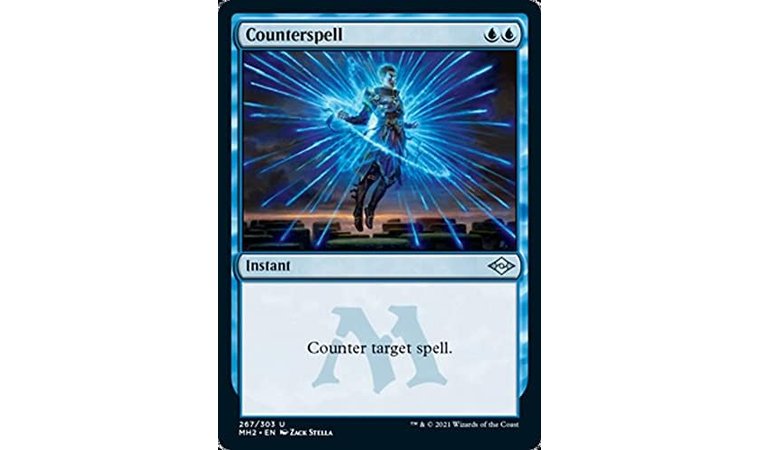
| Card Name | Counterspell |
| Mana Cost | {U}{U} (2 blue mana) |
| Card Type | Instant |
| Set Symbol & Rarity | Modern Horizons 2, Rare |
| Abilities | Counter target spell. |
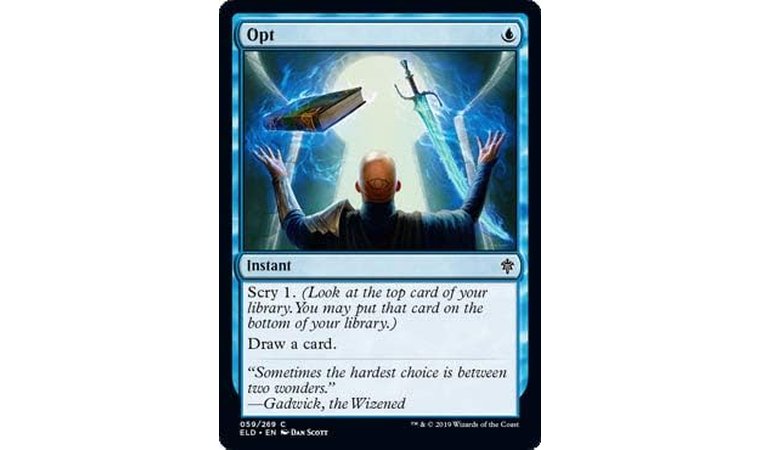
| Card Name | Opt |
| Mana Cost | {U} (1 blue mana) |
| Card Type | Instant |
| Set Symbol & Rarity | Throne of Eldraine, Common |
| Abilities | Scry 1. Draw a card. |
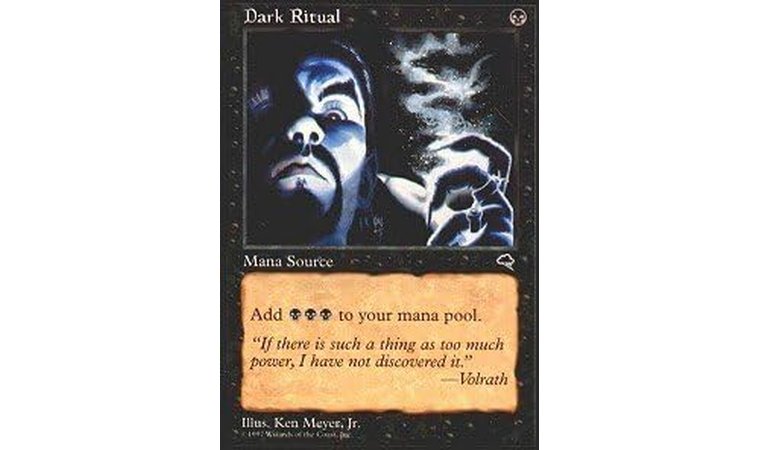
| Card Name | Dark Ritual |
| Mana Cost | {B} (1 black) |
| Card Type | Instant |
| Set Symbol & Rarity | Tempest (TMP), Common |
| Abilities | Add three black mana to your mana pool. |
4. Enchantments & Artifacts
Enchantments and artifacts stick around and change the game in ongoing ways. Enchantments often provide passive bonuses, control effects, or powerful triggers. Some enchant lands, creatures, or players directly.
Artifacts, on the other hand, are colorless magical objects with varied abilities – from mana-generating tools to game-winning machines.
Both types stay on the battlefield and build long-term advantages. They’re less flashy than creatures or spells, but extremely powerful when left unchecked.
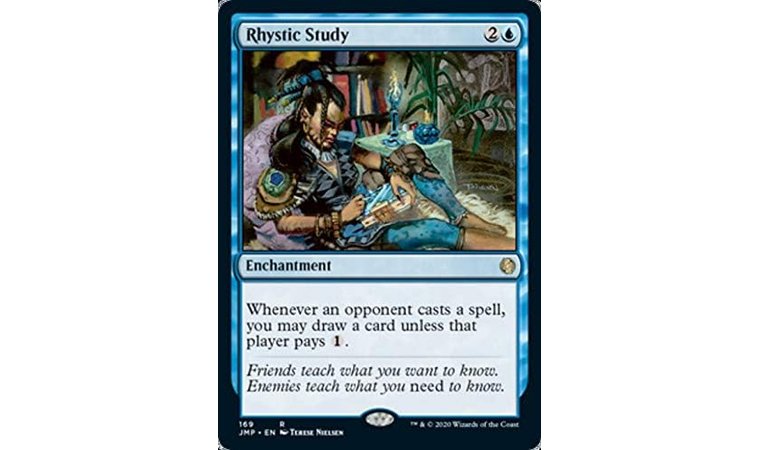
| Card Name | Rhystic Study |
| Mana Cost | {2}{U} (2 colorless, 1 blue) |
| Card Type | Enchantment |
| Set Symbol & Rarity | Jumpstart (JMP), Rare |
| Abilities | Whenever an opponent casts a spell, you may draw a card unless that player pays {1}. |
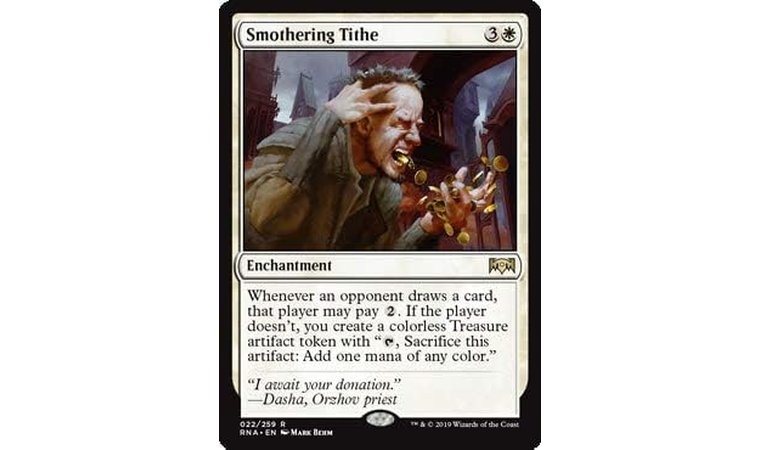
| Card Name | Smothering Tithe |
| Mana Cost | {3}{W} (3 colorless, 1 white) |
| Card Type | Enchantment |
| Set Symbol & Rarity | Ravnica Allegiance (RNA), Rare |
| Abilities | Whenever an opponent draws a card, that player may pay {2}. If the player doesn’t, you create a colorless Treasure artifact token. |
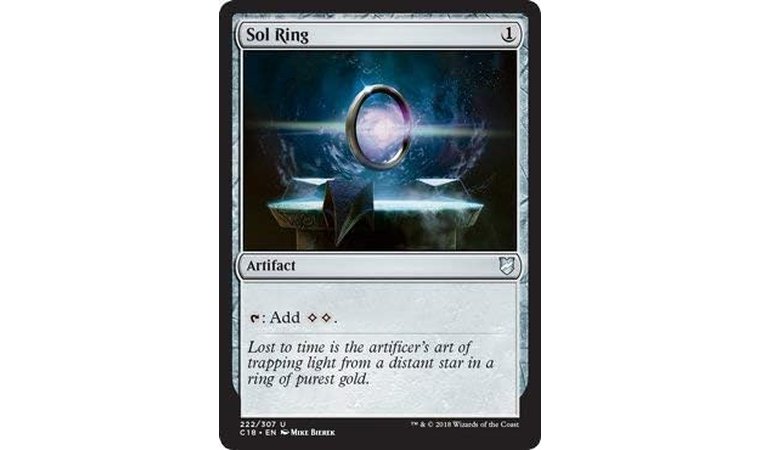
| Card Name | Sol Ring |
| Mana Cost | {1} (1 colorless mana) |
| Card Type | Artifact |
| Set Symbol & Rarity | Commander 2018 (C18), Uncommon |
| Abilities | Add two colorless mana to your mana pool. |
5. Sorceries
Sorceries are powerful spells with a twist – you can only play them on your own turn, during your main phase, when the stack is clear. This makes their timing more predictable than instants, but their effects are often just as impactful, if not more.
Think of sorceries as your big moves: drawing cards, dealing lots of damage, destroying multiple creatures, or even reshaping the board. After you cast them, they go straight to the graveyard.
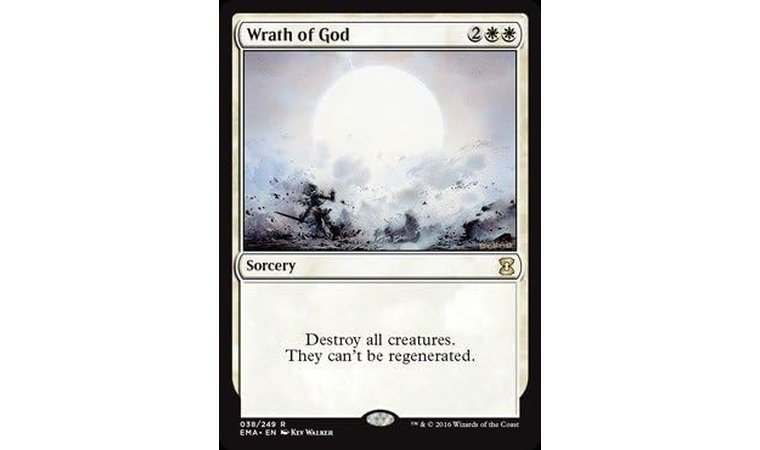
| Card Name | Wrath of God |
| Mana Cost | {2}{W}{W} (2 colorless, 2 white) |
| Card Type | Sorcery |
| Set Symbol & Rarity | Eternal Masters (EMA), Rare |
| Abilities | Destroy all creatures. They can’t be regenerated. |
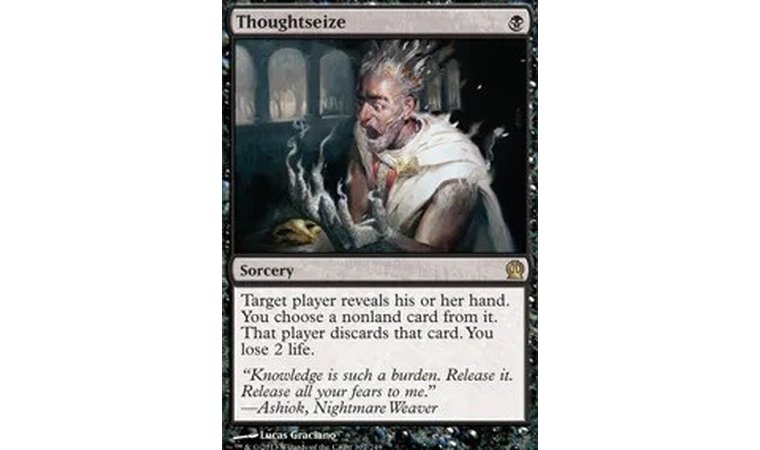
| Card Name | Thoughtseize |
| Mana Cost | {B} (1 black) |
| Card Type | Sorcery |
| Set Symbol & Rarity | Theros (THS), Rare |
| Abilities | Target player reveals their hand. You choose a nonland card from it. That player discards that card. You lose 2 life. |
MANA and Colors Explained
In Magic: The Gathering, mana is the energy that powers your spells, drawn from lands you play. Each land produces one of five colors of mana – White, Blue, Black, Red, or Green – each with a unique vibe and playstyle.
These colors shape your deck’s strategy, whether it’s controlling the game, overwhelming with aggression, or building unstoppable forces. Let’s dive into what each color represents and how it plays, giving you the tools to craft a deck that matches your style.
1. White Mana
White mana, tied to plains, embodies order, justice, and community. It shines in teamwork and protection, often focusing on healing, boosting life, and creating armies of small creatures like soldiers or angels.
White’s playstyle leans toward defense and board control, using spells to exile threats or prevent damage. Cards like “Banishing Light” remove dangers, while “Serra Angel” offers a vigilant flyer.
White decks excel at staying resilient, building a united front, and outlasting opponents through fairness and structure. If you love strategy that’s steady, righteous, and community-driven, White’s your go-to color for a disciplined victory.
2. Blue Mana
Blue mana, flowing from islands, is the color of intellect, trickery, and control. It’s all about outsmarting opponents with clever tactics – counterspells, card draw, and manipulation.
Blue decks thrive on control, disrupting enemy plans with cards like “Counterspell” or bouncing threats back to hands with “Unsummon.” Creatures like “Djinn of Wishes” bring flying and surprises.
Blue’s playstyle is patient, waiting for the perfect moment to strike while keeping the board locked down. If you enjoy mind games, precision, and staying one step ahead, Blue’s cunning and cerebral approach will make you a master manipulator.
3. Black Mana
Black mana, drawn from swamps, embraces ambition, power, and sacrifice. It’s the color of ruthless strategy, willing to pay costs, like life or creatures, for big rewards.
Black excels at destruction, with spells like “Doom Blade” to kill creatures or “Sign in Blood” for card draw at a price. Creatures like “Vampire Nighthawk” bring lifelink and menace.
Black’s playstyle is aggressive yet calculated, often draining opponents’ resources or reviving your own from the graveyard. If you’re drawn to dark, self-serving power and don’t mind a little risk, Black’s cutthroat edge will lead you to victory.
4. Red Mana
Red mana, sparked from mountains, is all about passion, chaos, and speed. It’s the color of aggression, hitting fast and hard with direct damage spells like “Lightning Bolt” or hasty creatures like “Goblin Guide.”
Red decks thrive on quick, explosive plays, overwhelming opponents before they can react. Its playstyle is reckless yet fun, burning through resources for immediate impact.
Red also disrupts with land destruction or random effects. If you love fast-paced, fiery action and living in the moment, Red’s wild, in-your-face energy will let you unleash chaos and charge straight to victory.
5. Green Mana
Green mana, rooted in forests, represents growth, strength, and nature. It’s the color of big creatures and raw power, summoning massive beasts like “Ghalta, Primal Hunger” to trample foes.
Green’s playstyle is about ramping – playing extra land cards or generating mana fast with cards like “Llanowar Elves” to cast huge spells early. It also boosts creatures with +1/+1 counters or buffs like “Giant Growth.”
Green decks overwhelm with sheer force, building an unstoppable board. If you love nurturing your army and crushing opponents with nature’s might, Green’s primal, growth-focused strategy will make you a battlefield titan.
Formats of Play
Magic: The Gathering offers a variety of play formats, each with its own rules and vibe, so you can find the perfect way to enjoy the game. Whether you want fast-paced competition, epic multiplayer battles, or chill games with friends, there’s a format for you.
Below, we break down four popular formats – Standard, Commander, Modern/Pioneer, and Casual – to help you pick your favorite.
1. Standard
Standard is a fast, accessible format perfect for new and competitive players. You build a 60-card deck using only recent card sets, typically from the last two years, keeping the game fresh and balanced. It’s played one-on-one, with 20 life per player.
Standard’s card pool rotates yearly, so strategies evolve, making it great for staying current with new cards. Decks often focus on synergy, like combining creatures and spells for quick wins.
You’ll see Standard at local game stores and big tournaments. It’s easy to jump into with prebuilt decks, and its streamlined rules make it a fun, dynamic way to test your skills against the latest Magic cards.
2. Commander
Commander is a fan-favorite format for epic, multiplayer fun. You build a 100-card deck around a legendary creature – your “commander” – and every card must match its color identity. No duplicates (except basic land cards) are allowed, making each deck unique. Players start at 40 life, and you can recast your commander if it’s removed.
Commander shines in casual group games, where alliances and wild plays create memorable moments.
Decks can be anything from goofy to cutthroat, with themes like dragons or zombies. It’s less about speed and more about big, splashy strategies. Grab a prebuilt Commander deck or craft your own for a social, creative Magic experience.
3. Modern/Pioneer
Modern and Pioneer are formats for players who love deep strategy and diverse cards. Modern uses cards from 2003 onward, while Pioneer starts from 2012, offering huge card pools for creative deck-building. Both are played one-on-one with 60-card decks and 20 life.
Modern has powerful, complex combos, while Pioneer is a bit simpler but still rich. These formats don’t rotate, so your deck stays legal forever, making them great for long-term players.
You’ll find intense competition at tournaments, with decks ranging from aggressive creatures to intricate control. If you enjoy tweaking decks and diving into Magic’s history, Modern or Pioneer offers endless possibilities to outsmart opponents.
4. Casual
Casual format is all about playing Magic your way, with no strict rules. You can use any cards, customize decks however you like, and play one-on-one or in groups. Life totals (usually 20) and deck sizes (at least 60 cards) are flexible, perfect for kitchen-table games with friends.
Casual is great for beginners or players who just want fun, low-pressure matches. Try wacky themes, like all-goblin decks, or mix cards from any era.
There’s no official ban list, so creativity rules. Whether you’re testing new ideas or enjoying a laid-back duel, Casual lets you focus on the joy of Magic without the stress of competitive play.
Tips for Beginners
Jumping into Magic: The Gathering is thrilling, and a few simple tips can make your first games way more fun. Here’s a quick guide to help you shine as a new planeswalker.
1. Play a Land Every Turn
Lands fuel your spells by generating mana. You can play one land per turn, so do it! This builds your mana pool, letting you cast bigger spells faster. Skipping a land drop can slow you down, so check your hand and get those lands on the battlefield.
2. Understand Your Card Types
Know your cards – creatures attack and block, instants are quick surprises, enchantments give ongoing effects, and lands power everything. Read each card’s text to grasp its role. This helps you plan combos and avoid surprises.
3. Think About Your Opponent’s Turn
Don’t just focus on your moves – consider what your opponent might do. Save an instant to counter their big spell or keep a creature back to block. Anticipating their strategy keeps you one step ahead and protects your life total.
4. Don’t Be Afraid to Attack/Block
Combat is key! Send creatures to chip away at your opponent’s life, but be smart – don’t overcommit if they might counterattack. Blocking can save you from big hits, so use your creatures to stay in the game.
5. Learn from Your Games
Every match teaches you something. Lost to a huge creature? Try adding removal spells. Won with a combo? Build on it. Reflect on what worked or didn’t to grow as a player. Keep practicing, and you’ll be casting like a pro!
FAQs
When did MTG come out?
Magic: The Gathering debuted in August 1993, created by Richard Garfield and published by Wizards of the Coast. The Alpha set kicked off the world’s first trading card game, revolutionizing gaming.
Where to buy MTG cards?
Buy Magic: The Gathering cards at local game stores, trusted online retailers like Amazon, TCGPlayer, StarCityGames, or Card Kingdom, or through eBay for rare finds. Check Wizards of the Coast’s site for official products or prebuilt decks.
How many Magic: The Gathering cards are there?
As of now, Magic: The Gathering has over 27,000 unique cards across numerous sets. New expansions are released regularly, adding to the total. Exact counts vary due to reprints and promos – check sites like Scryfall for updates.
What is Ward in MTG?
Ward is a keyword ability that makes a creature harder to target. When an opponent targets it with a spell or ability, they must pay an extra cost (like mana or life) or the spell fails.
What is a Mana ability?
A mana ability is an activated ability that adds mana to your mana pool, like tapping a land. It doesn’t use the stack, so it resolves instantly and can’t be countered, making it key for casting spells.
What does Vigilance mean in Magic: The Gathering?
Vigilance lets a creature attack without tapping. This means it can still block on your opponent’s turn, giving you offensive power and defensive flexibility. It’s great for keeping your defenses up while attacking.
What does Menace mean in Magic: The Gathering?
Menace makes a creature harder to block – it can only be blocked by two or more creatures. This forces your opponent to commit multiple blockers, making it easier for your creature to deal damage.




